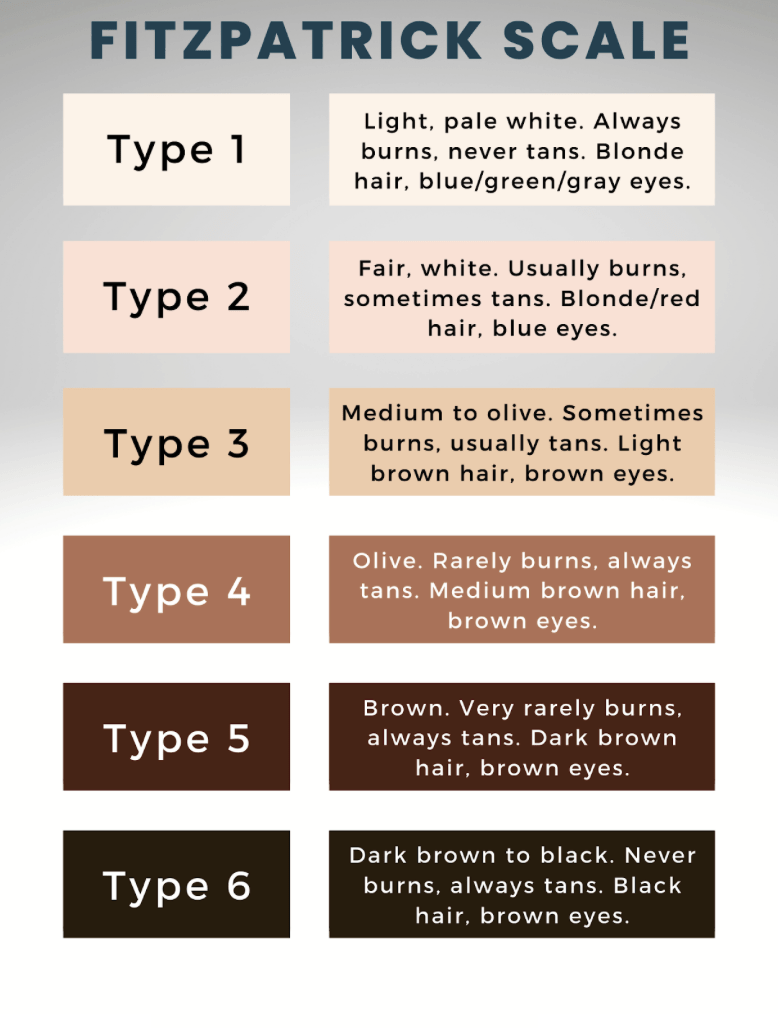The Fitzpatrick Scale: How Tatt2Away® Works for Different Skin Tones


The Fitzpatrick scale is a numerical classification system used to categorise different skin tones based on their response to sunlight. Developed in 1975, the Fitzpatrick scale has become a widely accepted tool in the field of dermatology.
The scale ranges from Type I, which refers to very fair skin that always burns and never tans, to Type VI, which refers to very dark skin that never burns and always tans. Dermatologists and other medical professionals use the Fitzpatrick scale to determine the appropriate treatment for a particular skin type and to assess the risk of skin reactions and other sun-related skin conditions.
In tattoo removal, the Fitzpatrick scale plays a crucial role in determining potential risks or skin reactions, such as keloids or hyper/hypo pigmentation, that might occur during the removal process. For example, darker skin types on the Fitzpatrick scale may be more prone to hyperpigmentation or scarring after microdermabrasion. This is because the treatment can sometimes trigger an overproduction of melanin or collagen in the treatment area. It is important to work with a trained and experienced professionals who can monitor the skins response to the treatment and adjust the procedure to minimise the risk of adverse effects. This is why we may opt for a test spot on clients before treating a whole area. Understanding a patient’s skin type on the Fitzpatrick scale helps practitioners tailor the tattoo removal approach to ensure safety and effectiveness. To learn more about the Tatt2Away removal process and how it works, click here.
There are no specific Fitzpatrick limitations to use precision dermabrasion for tattoo removal, as it does not target the pigment in the tattoo ink in the same way that laser tattoo removal does.



LASERS & THE COLOUR SPECTRUM
When it comes to tattoo removal, laser has a number of limitations that Tatt2away does not. Specifically, the term laser tattoo “removal” is a bit misleading because it doesn’t actually remove the ink from the body. Lasers heat the skin to 300degrees breaking down the ink into particles which are absorbed into the organs with potentially harmful side effects.
When it comes to laser for tattoo removal, individuals with darker skin types, such as Types IV, V, and VI on the Fitzpatrick scale, are at a higher risk of developing hypopigmentation or hyperpigmentation—changes in skin colour that can occur after tattoo removal.
This is because the lasers used in tattoo removal target the pigment in the skin and can also affect the surrounding skin tissue. Additionally, people with darker skin types may also be more prone to scarring or keloid formation after tattoo removal. It is crucial to seek out a skilled and experienced tattoo removal professional who can tailor the treatment to your specific needs.
Red ink can be more challenging to remove on darker skin tones because the laser used in tattoo removal targets pigment, and the colour red absorbs light differently than other colours. Red and warm ink tones require a specific wavelength of light to be absorbed by the ink particles. This wavelength is also heavily absorbed by melanin and melanocytes, leading to potential hypopigmentation and scarring from treatment with lasers.
THE ADVANTAGES OF NON-LASER TATTOO REMOVAL WITH TATT2AWAY
Expels Ink from the Skin
This non-laser treatment solution stimulates the body’s natural healing response to expel ink from the skin. The result is complete ink removal, unlike laser which forces the ink deeper into the organs of the body.
Safe on ALL Ink Colours
Whether your goal is a full tattoo removal or a revision, Tatt2Away effectively removes all ink colours – even those included in the ink ban!
All Natural Process
Tatt2Away patented technique uses precision dermabrasion with the application of Teprsol to remove ink naturally.
FDA Registered and CE Europe Seal
Our patented technology is FDA registered and holds the CE mark, signifying its approval for trading in Europe. Tatt2Away is now available in Australia & New Zealand.
